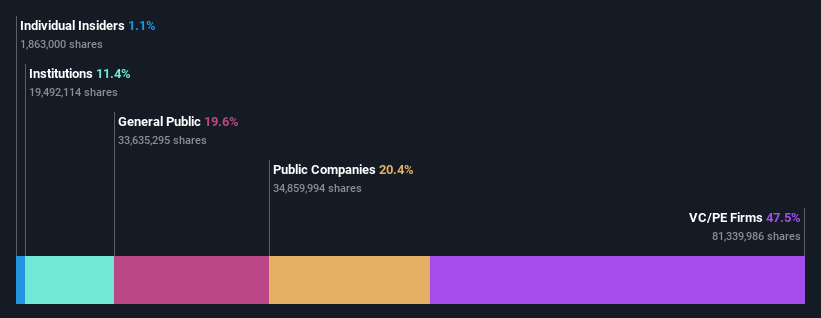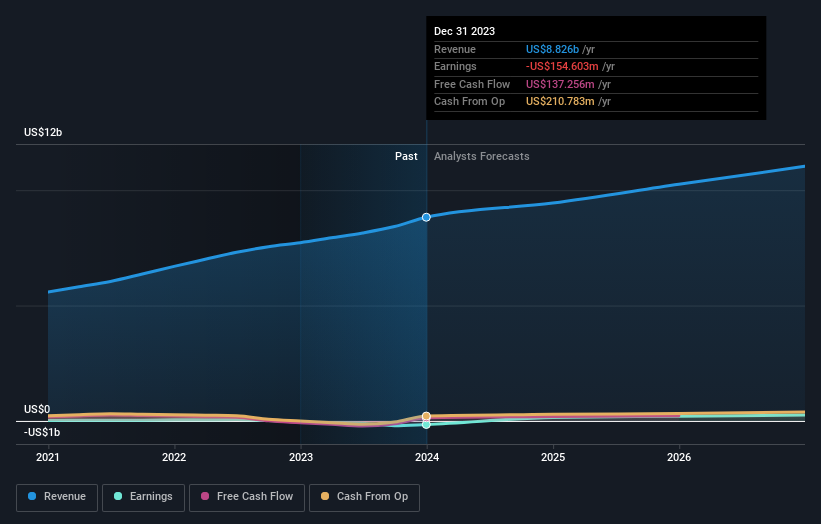While public companies own 20% of BrightSpring Health Services, Inc. (NASDAQ:BTSG), private equity firms are its largest shareholders with 48% ownership
Key Insights
BrightSpring Health Services' significant private equity firms ownership suggests that the key decisions are influenced by shareholders from the larger public
68% of the business is held by the top 2 shareholders
Every investor in BrightSpring Health Services, Inc. (NASDAQ:BTSG) should be aware of the most powerful shareholder groups. The group holding the most number of shares in the company, around 48% to be precise, is private equity firms. In other words, the group stands to gain the most (or lose the most) from their investment into the company.
And public companies on the other hand have a 20% ownership in the company.
Let's delve deeper into each type of owner of BrightSpring Health Services, beginning with the chart below.
View our latest analysis for BrightSpring Health Services
What Does The Institutional Ownership Tell Us About BrightSpring Health Services?
Many institutions measure their performance against an index that approximates the local market. So they usually pay more attention to companies that are included in major indices.
As you can see, institutional investors have a fair amount of stake in BrightSpring Health Services. This implies the analysts working for those institutions have looked at the stock and they like it. But just like anyone else, they could be wrong. It is not uncommon to see a big share price drop if two large institutional investors try to sell out of a stock at the same time. So it is worth checking the past earnings trajectory of BrightSpring Health Services, (below). Of course, keep in mind that there are other factors to consider, too.
We note that hedge funds don't have a meaningful investment in BrightSpring Health Services. KKR & Co. Inc. is currently the company's largest shareholder with 48% of shares outstanding. For context, the second largest shareholder holds about 20% of the shares outstanding, followed by an ownership of 4.8% by the third-largest shareholder. Additionally, the company's CEO Jon Rousseau directly holds 0.8% of the total shares outstanding.
After doing some more digging, we found that the top 2 shareholders collectively control more than half of the company's shares, implying that they have considerable power to influence the company's decisions.
While studying institutional ownership for a company can add value to your research, it is also a good practice to research analyst recommendations to get a deeper understand of a stock's expected performance. Quite a few analysts cover the stock, so you could look into forecast growth quite easily.
Insider Ownership Of BrightSpring Health Services
The definition of company insiders can be subjective and does vary between jurisdictions. Our data reflects individual insiders, capturing board members at the very least. Company management run the business, but the CEO will answer to the board, even if he or she is a member of it.
Insider ownership is positive when it signals leadership are thinking like the true owners of the company. However, high insider ownership can also give immense power to a small group within the company. This can be negative in some circumstances.
Shareholders would probably be interested to learn that insiders own shares in BrightSpring Health Services, Inc.. This is a big company, so it is good to see this level of alignment. Insiders own US$19m worth of shares (at current prices). It is good to see this level of investment by insiders. You can check here to see if those insiders have been buying recently.
General Public Ownership
With a 20% ownership, the general public, mostly comprising of individual investors, have some degree of sway over BrightSpring Health Services. This size of ownership, while considerable, may not be enough to change company policy if the decision is not in sync with other large shareholders.
Private Equity Ownership
Private equity firms hold a 48% stake in BrightSpring Health Services. This suggests they can be influential in key policy decisions. Some investors might be encouraged by this, since private equity are sometimes able to encourage strategies that help the market see the value in the company. Alternatively, those holders might be exiting the investment after taking it public.
Public Company Ownership
Public companies currently own 20% of BrightSpring Health Services stock. This may be a strategic interest and the two companies may have related business interests. It could be that they have de-merged. This holding is probably worth investigating further.
Next Steps:
I find it very interesting to look at who exactly owns a company. But to truly gain insight, we need to consider other information, too.
I like to dive deeper into how a company has performed in the past. You can access this interactive graph of past earnings, revenue and cash flow, for free.
If you would prefer discover what analysts are predicting in terms of future growth, do not miss this free report on analyst forecasts.
NB: Figures in this article are calculated using data from the last twelve months, which refer to the 12-month period ending on the last date of the month the financial statement is dated. This may not be consistent with full year annual report figures.
Have feedback on this article? Concerned about the content? Get in touch with us directly. Alternatively, email editorial-team (at) simplywallst.com.
This article by Simply Wall St is general in nature. We provide commentary based on historical data and analyst forecasts only using an unbiased methodology and our articles are not intended to be financial advice. It does not constitute a recommendation to buy or sell any stock, and does not take account of your objectives, or your financial situation. We aim to bring you long-term focused analysis driven by fundamental data. Note that our analysis may not factor in the latest price-sensitive company announcements or qualitative material. Simply Wall St has no position in any stocks mentioned.

 Yahoo Finance
Yahoo Finance 

